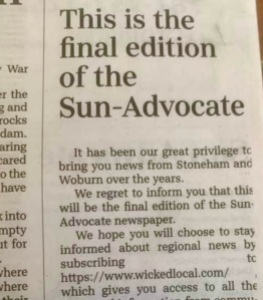
This week we learned that the Environmental Protection Agency is proposing to ban trichloroethylene, better known as TCE, an industrial solvent that has been linked to leukemia, birth defects, reproductive problems and other health issues.
As Michael Casey of The Associated Press notes, TCE was at the center of a major story in Woburn, Massachusetts, in the late 1970s and ’80s, when six children died of leukemia and a landmark lawsuit was brought in U.S. District Court. The lawsuit alleged that those deaths and a range of other illnesses had been caused by exposure to TCE in the drinking water. But none of that might have happened if not for the reporting of Charles Ryan, then a young reporter at The Daily Times Chronicle in Woburn. I was working at the paper at the time, and I remember what an enormous impact Charlie’s reporting had on advancing the battle against toxic waste.
Charlie had already reported on the discovery of contamination in the drinking water as well as suspicions that it was linked to a cluster of leukemia cases in East Woburn. The question that had to be answered was whether the cluster was statistically significant enough that it warranted further investigation. In December 1979, the state was about to release the results of a study. Charlie was set to go into Boston and get a copy of the report. Somehow, the story leaked out early, and the Boston Herald American reported the findings: no statistical significance. “I was a little pissed,” Charlie told me years later. “But I went in there anyway.”
Charlie quickly realized that state investigators had made a math error — they were using Woburn’s 1970 population of 40,000, whereas by 1979 that had dropped to 36,000. Correct the denominator, and the leukemia cluster moved into the zone of statistical significance. “That story changed everything,” Charlie told me. His reporting didn’t set well with Woburn’s old-line establishment, and he remembered once being told, “Your father would be turning over in his grave if he knew what you were doing to his city.” Charlie’s response: “That means you didn’t know my father very well.”
Later on, I covered some aspects of the story and was in court for all but five days of the 78-day civil trial. I covered the appeals process, too. The trial was the subject of a terrific book called “A Civil Action,” by Jonathan Harr, and a not-so-terrific movie starring John Travolta. The trial didn’t end well for the eight families who sued. One of the three defendants settled out of court before the trial, a second was cleared by the jury, and the third, W.R. Grace, settled for a paltry $8 million after being found liable for contaminating the water. The jury never had a chance to determine whether the contamination had actually caused the illnesses that were at the heart of the case.
Charlie is now retired after a lengthy career in journalism and continues to live in Woburn. The proposed ban on TCE is long overdue, and it’s part of his legacy as a reporter. It’s also a testament to the vital importance of local news that holds powerful interests to account.
Leave a comment | Read comments






 Why does it matter for a community to have a variety of journalistic voices? We could all point to any number of examples. But the example I want to discuss here is a story about brain cancer among Pratt & Whitney employees in Greater New Haven.
Why does it matter for a community to have a variety of journalistic voices? We could all point to any number of examples. But the example I want to discuss here is a story about brain cancer among Pratt & Whitney employees in Greater New Haven.